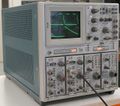7514: Difference between revisions
No edit summary |
No edit summary |
||
| Line 19: | Line 19: | ||
The stored writing speed is 1 cm/sec. | The stored writing speed is 1 cm/sec. | ||
==Background== | |||
Regarding the 7514, Ron Barrett WB7PMP says: | |||
<blockquote> | |||
I used to work at Tek and took the opportunity to purchase a 7514 from Tek Surplus in 1978. | |||
I have used it on and off over the years and it has never quit. | |||
The 7514 was the pinnacle of the original generation 7000 series. | |||
As I found out from it's project manager and my division engineering manager at the time it pushed design to the limit in two areas. | |||
The basic electrical and mechanical design was based on the 7504 which is a real boat-anchor. | |||
In order to supply the additional power for storage and to reduce weight, | |||
one of the first switching power supplies to appear in test and measurement equipment was designed. | |||
This was a nontrivial achievement in the late 60's. | |||
The resulting design with some modifications was used for all subsequent 7000 series mainframes. | |||
When combined with the goal to not degrade 7504 on-screen performance, | |||
elevated storage with split-screen capabilities and every storage function imagined at the time | |||
made electrical design difficult and CRT design nearly impossible. | |||
Lesson learned: future generations of Tek CRT storage did not try to serve all needs. | |||
So the 7514 is somewhat unique, was very expensive and had a relatively short life in production | |||
as Tek rushed to introduce second generation products which were cheaper to produce. | |||
No more gold circuit boards like those used in the 7514. | |||
There have been a few of these pop up on E-bay but none have approached the condition of this one. | |||
I completely calibrated it several years ago and checked it out just prior to listing. | |||
As you can see from the photos, storage works fine and non-store rise time is about 3ns with very clean transient response. | |||
Measured bandwidth was 108 MHz and would be more if the spec. on aberrations was pushed to the limit. | |||
Spot size, trace noise and writing rate are what one would expect. | |||
</blockquote> | |||
==Links== | ==Links== | ||
| Line 25: | Line 51: | ||
==Pictures== | ==Pictures== | ||
<gallery> | <gallery> | ||
File:Tek 7514 1.jpg | |||
File:Tek 7514 3.jpg | |||
File:Tek 7514 4.jpg | |||
File:Tek 7514 5.jpg | |||
File:Tek 7514 6.jpg | |||
File:Tek 7514 7.jpg | |||
File:Tek 7514 8.jpg | |||
File:Tek 7514 9.jpg | |||
File:Tek 7514 2.jpg|Spare boards from a 7504 also work in the 7514 | |||
File:Tek7514.jpg | 7514 | File:Tek7514.jpg | 7514 | ||
File:7514_Front.jpg | 7514 Front | File:7514_Front.jpg | 7514 Front | ||
Revision as of 02:27, 4 June 2016
The Tektronix 7514 is a 90 MHz split-screen bistable CRT storage scope.
It can take four 7000-series plug-ins, two for vertical and two for horizontal.
Specifications
please add
The non-stored writing speed is 450 cm/sec. The stored writing speed is 1 cm/sec.
Background
Regarding the 7514, Ron Barrett WB7PMP says:
I used to work at Tek and took the opportunity to purchase a 7514 from Tek Surplus in 1978. I have used it on and off over the years and it has never quit. The 7514 was the pinnacle of the original generation 7000 series. As I found out from it's project manager and my division engineering manager at the time it pushed design to the limit in two areas. The basic electrical and mechanical design was based on the 7504 which is a real boat-anchor. In order to supply the additional power for storage and to reduce weight, one of the first switching power supplies to appear in test and measurement equipment was designed. This was a nontrivial achievement in the late 60's. The resulting design with some modifications was used for all subsequent 7000 series mainframes. When combined with the goal to not degrade 7504 on-screen performance, elevated storage with split-screen capabilities and every storage function imagined at the time made electrical design difficult and CRT design nearly impossible. Lesson learned: future generations of Tek CRT storage did not try to serve all needs. So the 7514 is somewhat unique, was very expensive and had a relatively short life in production as Tek rushed to introduce second generation products which were cheaper to produce. No more gold circuit boards like those used in the 7514. There have been a few of these pop up on E-bay but none have approached the condition of this one. I completely calibrated it several years ago and checked it out just prior to listing. As you can see from the photos, storage works fine and non-store rise time is about 3ns with very clean transient response. Measured bandwidth was 108 MHz and would be more if the spec. on aberrations was pushed to the limit. Spot size, trace noise and writing rate are what one would expect.
Links
Pictures
-
-
-
-
-
-
-
-
-
Spare boards from a 7504 also work in the 7514
-
7514
-
7514 Front











